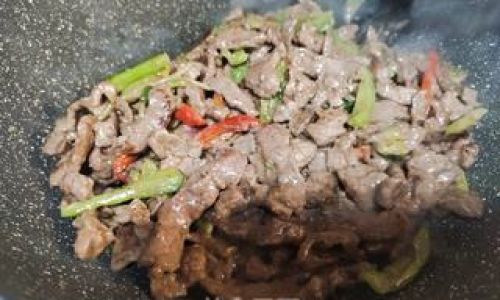Introduction
Stir-fried beef slices, a cornerstone of Asian cuisine, have captivated taste buds worldwide with their harmonious blend of tender meat, crisp vegetables, and savory sauces. This dish, known for its quick cooking time and bold flavors, is a testament to the precision and creativity of stir-frying techniques. Whether you’re a novice cook or a seasoned home chef, mastering the art of stir-fried beef slices opens doors to endless culinary possibilities. This article delves into the history, techniques, and secrets behind creating restaurant-quality stir-fried beef slices at home. From selecting the perfect cut of meat to nailing the ideal balance of sweet, salty, and umami flavors, we’ll explore every facet of this iconic dish.
The History and Cultural Significance of Stir-Fried Beef
Stir-frying, a cooking method that originated in China over 2,000 years ago, revolutionized quick-cooking techniques by utilizing high heat and minimal oil to preserve ingredients’ textures and nutrients. Beef, once a luxury ingredient reserved for special occasions, became more accessible over time, leading to its integration into everyday stir-fry dishes. In regions like Sichuan, Cantonese, and Korean cuisine, stir-fried beef evolved into distinct regional specialties, each with unique seasonings and preparations. Today, this dish symbolizes the fusion of tradition and innovation, adapting to local tastes while honoring its roots.
Ingredients: Building the Foundation of Flavor
Creating the perfect stir-fried beef slices begins with selecting high-quality ingredients. Here’s a breakdown of the essential components:

-
Beef Selection:
- Cut: Flank steak, sirloin, or ribeye are ideal for stir-fries due to their tenderness and marbling. Avoid tough cuts like chuck or round unless using a meat tenderizer.
- Preparation: Slice the beef against the grain into thin, uniform strips (about ¼-inch thick) to ensure even cooking and tenderness.
-
Marinade:
A well-crafted marinade elevates the beef’s flavor and texture. Key ingredients include:- Soy sauce: Provides saltiness and umami.
- Oyster sauce: Adds depth and a subtle sweetness.
- Cornstarch: Acts as a tenderizer and thickener for the sauce.
- Baking soda (optional): A pinch can break down tough meat fibers.
- Sesame oil: Imparts a nutty aroma.
- Shaoxing wine or rice wine: Enhances complexity.
-
Vegetables and Aromatics:
- Bell peppers, onions, and broccoli: Offer crunch and color.
- Garlic and ginger: Freshly minced for aromatic punch.
- Scallions or cilantro: For garnish.
-
Sauce Base:
Combine soy sauce, oyster sauce, sugar, and a splash of broth or water. Adjust ratios to taste. -
Cooking Oil:
Use a neutral oil with a high smoke point, such as peanut or canola oil.
Step-by-Step Cooking Process

Marinating the Beef
Marinating is not just about flavor—it’s about tenderization. In a bowl, combine 1 lb of sliced beef with 1 tbsp soy sauce, 1 tbsp oyster sauce, 1 tsp cornstarch, ½ tsp baking soda (if using), and 1 tsp sesame oil. Mix thoroughly and let it sit for 20–30 minutes. This step ensures the meat remains juicy and develops a velvety texture.
Preparing the Vegetables
Cut vegetables into uniform pieces to ensure even cooking. Bell peppers should be julienned, onions sliced into wedges, and broccoli florets separated. Mince 2 garlic cloves and 1 tbsp of ginger.
Mastering the Stir-Fry Technique
Stir-frying demands high heat and constant motion. Here’s how to execute it flawlessly:
- Heat the Wok: Preheat a carbon-steel wok or large skillet over high heat until smoking. Add 2 tbsp of oil and swirl to coat.
- Sear the Beef: Add the marinated beef in a single layer, spreading it out to avoid steaming. Let it cook undisturbed for 1–2 minutes until caramelized, then stir-fry for another minute. Remove and set aside.
- Stir-Fry Vegetables: In the same wok, add a touch more oil if needed. Toss in garlic and ginger, stirring until fragrant (30 seconds). Add vegetables, starting with denser ones like broccoli, and stir-fry for 2–3 minutes.
- Reintroduce the Beef: Return the beef to the wok along with the sauce. Toss vigorously to coat everything evenly.
- Thicken the Sauce: If desired, mix 1 tsp cornstarch with 2 tbsp water and stir into the wok until the sauce clings to the ingredients.
Finishing Touches
Garnish with sliced scallions, sesame seeds, or a drizzle of chili oil. Serve immediately with steamed rice or noodles.
Expert Tips for Perfect Stir-Fried Beef
-
Temperature Control:

A smoking-hot wok ensures rapid searing, locking in juices. Avoid overcrowding the pan, as this lowers the temperature and steams the ingredients.
-
Velveting Technique:
For extra-tender beef, try the “velveting” method: marinate the meat in a mixture of egg white, cornstarch, and oil before blanching in hot water or oil.
-
Sauce Consistency:
Adjust the cornstarch ratio based on desired thickness. A thinner sauce coats the ingredients lightly, while a thicker sauce clings like a glaze.
-
Flavor Variations:

- Spicy: Add dried chili flakes or Sichuan peppercorns.
- Sweet: Incorporate a touch of honey or hoisin sauce.
- Citrusy: Finish with a squeeze of lime or orange zest.
Regional Adaptations and Creative Twists
-
Sichuan-Style Beef Stir-Fry:
Infuse the dish with Sichuan peppercorns, doubanjiang (chili bean paste), and a splash of black vinegar for a numbing, spicy kick. -
Korean-Inspired Bulgogi:
Marinate beef in a mixture of soy sauce, pear juice, garlic, and sugar, then stir-fry with carrots and enoki mushrooms. -
Thai Basil Beef (Pad Krapow):
Toss beef with Thai basil, bird’s eye chilies, and fish sauce for a fragrant, aromatic dish. -
Low-Carb Version:
Serve over cauliflower rice or shirataki noodles for a gluten-free, keto-friendly meal.
Troubleshooting Common Mistakes

- Tough Beef: Overcooking or slicing with the grain. Always slice against the grain and cook briefly over high heat.
- Soggy Vegetables: Overcrowding the pan. Stir-fry vegetables in batches if necessary.
- Bland Flavor: Under-seasoning. Taste and adjust the sauce before serving.
- Burnt Sauce: Cooking the sauce too long. Remove the wok from heat once the sauce thickens.
Health Benefits and Nutritional Value
Stir-fried beef slices offer a nutrient-dense meal rich in protein, iron, and vitamins from the vegetables. Opting for lean cuts and minimal oil reduces calorie content, while fresh herbs and spices add antioxidants. For a balanced meal, pair with fiber-rich sides like brown rice or quinoa.
Conclusion
Stir-fried beef slices embody the essence of Asian cooking: simplicity, speed, and spectacular flavor. By mastering the techniques outlined here—from marinating to managing heat—you can recreate this classic dish with confidence. Experiment with regional spices, seasonal vegetables, and personal preferences to make it uniquely yours. Whether you’re cooking a quick weeknight dinner or impressing guests, stir-fried beef slices are a timeless choice that never fails to delight. So grab your wok, sharpen your knife, and embark on a culinary adventure that bridges tradition and innovation, one sizzling stir-fry at a time.





0 comments